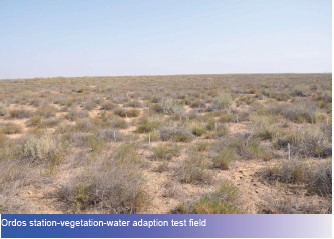The National Research Station for Ordos Grassland Ecosystems (NRS-OGE, 39°29'37.6'' N, 110°11'9.4'' E, 1300 m.a.s.l.) is located in Yijinhuoluo County, Ordos City, Inner Mongolia. The NRS-OGE is one of the member stations belonging to Chinese Ecosystem Research Network (CERN) and is also one of national field stations belonging to the Chinese National Ecosystem Observation and Research Network (CNERN). The representative ecosystems featured by NRS-OGE are grassland ecosystems in steppe zone. The NRS-OGE now has a multi-function building of 2000 m2, an experimental area of 2133.33 hm2, a set of monitoring equipments, an internet service with 10 M flux and able to access digital resources of CAS, especially IOB. In 2011, the NRS-OGE was successful in conducting all monitoring projects for CERN and CNERN and served about 100 domestic and international researchers and academic visitors, which have worked at the station for more than 1,600 days.
The main work included five aspects as followings: 1) Monitoring: field monitoring and laboratory sample analysis tasks of water, soil, atmosphere and biological factors were accomplished on time according to CERN and CNERN requirements; At the same time we cooperated with each CERN sub-center to improve quality control system of stations monitoring data; 2) Research: We carried out experiments about seed ecology, responses of plant to wind-induced mechanical stimulation, long-term experiments about relationships between vegetation and water, and responses of the relationship to global change; 3) Cooperation with local governments: The Observation Plot and Atmospheric Observation Field of Engebei branch of Ordos Sandland Ecological Research Station, CAS were finished, at the same time, three long-term research and monitoring platforms were established; 4) Demonstration: The project "Technology and demonstration of Ordos sandy ecosystem adapting to water stress" was launched; 5) Science Popularization: We offered some science popularizing activities about Sandy Grassland Ecology for 102 students from Beijing Chenjinglun Middle Schools, and the station was titled "Science Popularizing Station of Sandland Management".

The main work included five aspects as followings: 1) Monitoring: field monitoring and laboratory sample analysis tasks of water, soil, atmosphere and biological factors were accomplished on time according to CERN and CNERN requirements; At the same time we cooperated with each CERN sub-center to improve quality control system of stations monitoring data; 2) Research: We carried out experiments about seed ecology, responses of plant to wind-induced mechanical stimulation, long-term experiments about relationships between vegetation and water, and responses of the relationship to global change; 3) Cooperation with local governments: The Observation Plot and Atmospheric Observation Field of Engebei branch of Ordos Sandland Ecological Research Station, CAS were finished, at the same time, three long-term research and monitoring platforms were established; 4) Demonstration: The project "Technology and demonstration of Ordos sandy ecosystem adapting to water stress" was launched; 5) Science Popularization: We offered some science popularizing activities about Sandy Grassland Ecology for 102 students from Beijing Chenjinglun Middle Schools, and the station was titled "Science Popularizing Station of Sandland Management".

